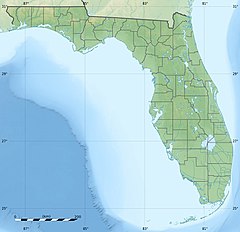Cape Canaveral Light

The Cape Canaveral Lighthouse in 2009, after intensive restoration.
|
|
|
Location in Florida
|
|
| Location | one mile inland from Cape Canaveral Florida United States |
|---|---|
| Coordinates | 28°27′37.26″N 80°32′36.42″W / 28.4603500°N 80.5434500°WCoordinates: 28°27′37.26″N 80°32′36.42″W / 28.4603500°N 80.5434500°W |
| Year first constructed | 1848 (first) |
| Year first lit | 1868 (current) |
| Automated | 1960 |
| Foundation | brick basement |
| Construction | cast iron plate with brick lining tower |
| Tower shape | tapered cylindrical tower with balcony and lantern |
| Markings / pattern |
1868: white 1873: black and white horizontal bands with white lantern room 1894: black and white horizontal bands with black lantern room |
| Height | 151 feet (46 m) |
| Focal height | 137 feet (42 m) |
| Original lens | first-order Fresnel lens |
| Current lens | DCB-224 (1993) |
| Range |
1st order: 18 nautical miles (33 km; 21 mi) Current: 24 nautical miles (44 km; 28 mi) |
| Characteristic |
1st order: flashing white every minute - flash 5 secs, eclipse 55 secs. Current: Fl (2) W 20s. 0.2s fl 4.8 secs. 0.2s fl 14.8 secs. |
| Admiralty number | J2888 |
| NGA number | 11484 |
| ARLHS number | USA-108 |
| USCG number | 625 |
| Managing agent | Patrick Air Force Base |
The Cape Canaveral Light is a historic lighthouse on the east coast of the U.S. state of Florida. The light was established in 1848 to warn ships of the dangerous shoals that lie off its coast. It is located inside the Cape Canaveral Air Force Station and managed by the 45th Space Wing of the U.S. Air Force with the assistance of the Cape Canaveral Lighthouse Foundation. It is the only fully operational lighthouse that is owned by the United States Air Force.
The current 151-foot (46 m) lighthouse tower was first erected and lit in 1868 then relocated further inland between 1893-1894. It was originally equipped with a first-order Fresnel lens that was automated in 1967 and then retired from the tower in 1993.
The Cape Canaveral lighthouse was erected to warn mariners of the outlying shoals off its coast. Broken ground and shoals extend 13 nautical miles (24 km; 15 mi) northward and northeastward of the lighthouse terminating in the Hetzel and Ohio shoals, which have a depth of 11 ft (3.4 m) and 19 ft (5.8 m) respectively. Hetzel Shoal is located about 13.5 nautical miles (25.0 km; 15.5 mi) NE of the lighthouse and Ohio Shoals about 2.3 nautical miles (4.3 km; 2.6 mi) southward of Hetzel. In a heavy sea these shoals are marked by breakers, but with smooth sea there is nothing to indicate their locality. The land is usually not visible from off these outer shoals. Located closer to the land are the Chester, Bull and Southeast shoals, which are about 4.5 to 7.5 nautical miles (8.3 to 13.9 km; 5.2 to 8.6 mi) off the coast of the cape.
The current Cape Canaveral Light is not the first lighthouse constructed on Cape Canaveral. On May 21, 1838, the building of the first lighthouse at the cape was requested by Florida territorial delegate Charles Downing. Nathaniel Scobie was appointed as the first lighthouse keeper and oversaw the construction of the lighthouse. The 65-foot (20 m) tall white conical brick tower and keeper's dwelling were completed in January 1848 at the cost of $13,300. Its light consisted of 15 Lewis lamps powered by whale oil, each with a 21-inch (530 mm) reflector. The lamps were set on a chandelier rotated via clockwork.
...
Wikipedia

